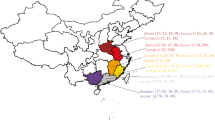Abstract
Porcine hokovirus (PHoV), a newly discovered member of the family Parvoviridae and the proposed genus Hokovirus, is considered phylogenetically distinct from other parvoviruses. Here, we report a comprehensive spatio-temporal study of PHoV infection in Romanian wild boars. The prevalence of PHoV differed significantly in samples from 2006/2007 (22.76%) and 2010/2011 (50.54%), and also increased with age. Sequence analysis of PHoVs from 2006/2007 showed a close relationship to PHoVs from pigs from England and wild boars from Germany, while the PHoVs from 2010/2011 were mostly similar to isolates from Hong Kong. The most variable regions were detected in the NS1 gene and proved to be suitable for analysis of the genetic diversity of the virus. It was observed that PHoVs from older wild boar samples differed from those collected recently. These results suggested that porcine hokovirus could be a newly emerging virus of both domestic and wild pigs with yet unknown implications.



Similar content being viewed by others
References
Adlhoch C, Kaiser M, Ellerbrok H, Pauli G (2010) High prevalence of porcine Hokovirus in German wild boar populations. Virol J 7:171
Allander T, Tammi MT, Eriksson M, Bjerkner A, Tiveljung-Lindell A, Andersson B (2005) Cloning of a human parvovirus by molecular screening of respiratory tract samples. Proc Natl Acad Sci USA 102:12891–12896
Altschul SF, Madden TL, Schäffer AA, Zhang J, Zhang Z, Miller W, Lipman J (1997) Gapped BLAST and PSI-BLAST: a new generation of protein database search programs. Nucl Acids Res 25:3389–3402
Blomström A, Belák S, Fossum C, McKillen J, Allan G, Wallgren P, Berg M (2009) Detection of a novel porcine boca-like virus in the background of porcine circovirus type 2 induced postweaning multisystemic wasting syndrome. Virus Res 146:125–129
Cheng W-x, Li J-s, Huang C-p, Yao D-p, Liu N et al (2010) Identification and nearly full-length genome characterization of novel porcine bocaviruses. PLoS ONE 5(10):e13583. doi:10.1371/journal.pone.0013583
Cheung AK, Wu G, Wang D, Bayles DO, Lager KM et al (2010) Identification and molecular cloning of a novel porcine parvovirus. Arch Virol 155:801–806
Fauquet CM, Mayo MA, Maniloff J, Desselberger U, Ball LA (eds) (2005) Virus taxonomy and nomenclature of viruses. 8th report of the international committee on taxonomy of viruses. Elsevier, London, pp 353–363
Hall TA (1999) BioEdit: a user-friendly biological sequence alignment editor and analysis program for Windows 95/98/NT. Nucl Acids Symp Ser 41:95–98
Lau SK, Woo PC, Tse H, Fu CT, Au WK, Chen XC, Tsoi HW, Tsang TH, Chan JS, Tsang DN et al (2008) Identification of novel porcine and bovine parvoviruses closely related to human parvovirus 4. J Gen Virol 89:1840–1848
Lau SK, Yip CCY, Que TL, Lee RA, Au-yeung R, Zhou BP, So LY, Lau YL, Chan KH et al (2007) Clinical and molecular epidemiology of human bocavirus in respiratory and fecal samples from children in Hong Kong. J Infect Dis 196:986–993
McKillen J, McNeilly F, Duffy C, McMenamy M, McNair I, Hjertner B, Millar A, McKay K, Lagan P, Adair B, Allan G (2011) Isolation in cell cultures and initial characterisation of two novel bocavirus species from swine in Northern Ireland. Vet Microbiol. doi:10.1016/j.vetmic.2011.04.013
Simmonds P, Douglas J, Bestetti G, Longhi E, Antinori S, Parravicini C, Corbellino M (2008) A third genotype of the human parvovirus PARV4 in sub-Saharan Africa. J Gen Virol 89:2299–2302
Sloots TP, McErlean P, Speicher DJ, Arden KE, Nissen MD, Mackay IM (2006) Evidence of human coronavirus HKU1 and human bocavirus in Australian children. J Clin Virol 35:99–102
Szelei J, Liu K, Li Y, Fernandes S, Tijssen P (2010) Parvovirus 4-like virus in blood products. Emerg Infect Dis 16:561–564
Tamura K, Peterson D, Peterson N, Stecher G, Nei M, Kumar S (2011) MEGA5: molecular evolutionary genetics analysis using maximum likelihood, evolutionary distance, and maximum parsimony methods. Mol Biol Evol. doi:10.1093/molbev/msr121
Acknowledgments
This work was supported by CNCSIS-UEFISCDU, PN II-RU PD-5 189/2010. Research studies of Dr. Cságola were funded by the János Bolyai Research Scholarship of the Hungarian Academy of Science. The authors thank the Balassi Institute - Hungarian Scholarship Board Office.
Conflict of interest
The authors declare that they have no conflict of interest.
Author information
Authors and Affiliations
Corresponding author
Rights and permissions
About this article
Cite this article
Cadar, D., Cságola, A., Lőrincz, M. et al. Distribution and genetic diversity of porcine hokovirus in wild boars. Arch Virol 156, 2233–2239 (2011). https://doi.org/10.1007/s00705-011-1125-6
Received:
Accepted:
Published:
Issue Date:
DOI: https://doi.org/10.1007/s00705-011-1125-6




